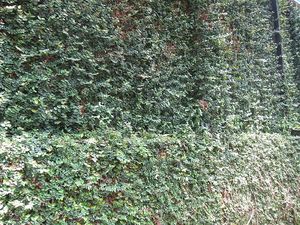Note: This is a project under development. The articles on this wiki are just being initiated and broadly incomplete. You can Help creating new pages.
Difference between revisions of "Ficus pumila - Malayu"
(→Commonly seen growing in areas) |
(→Photo Gallery) |
||
| Line 60: | Line 60: | ||
==Photo Gallery== | ==Photo Gallery== | ||
<gallery class="left" caption="" widths="140px" heights="140px"> | <gallery class="left" caption="" widths="140px" heights="140px"> | ||
| − | + | Awkeotsang Makino Corner.JPG | |
| + | Climbing Fig (Ficus pumila) 1.jpg | ||
| + | Climbing Fig (Ficus pumila) 2.jpg | ||
| + | Climbing Fig (Ficus pumila) 3.jpg | ||
| + | Climbing Fig (Ficus pumila).jpg | ||
| + | Creeping Fig Ficus pumila.JPG | ||
</gallery> | </gallery> | ||
Revision as of 14:17, 18 February 2019
Ficus pumila is a species of flowering plant in the mulberry family, native to East Asia (China, Japan, Vietnam) and naturalized in parts of the southeastern and south-central United States. This species has been widely grown as an ornamental. In China, Taiwan, and Japan, it is commercially cultivated to make jellies from the fruit.
Contents
- 1 Uses
- 2 Parts Used
- 3 Chemical Composition
- 4 Common names
- 5 Properties
- 6 Habit
- 7 Identification
- 8 List of Ayurvedic medicine in which the herb is used
- 9 Where to get the saplings
- 10 Mode of Propagation
- 11 How to plant/cultivate
- 12 Commonly seen growing in areas
- 13 Photo Gallery
- 14 References
- 15 External Links
Uses
Impotence, Lumbago, Rheumatism, Anaemia, Haematuria, Chronic dysentery, Haemorrhoids
Parts Used
Chemical Composition
Kaempferol, Rhamnopyranosyl, Glucopyranoside, Isoquercitrin, Quercitrin, Dihydrokaempferol, Glucopyranoside, Dihydro-kaempferol, Glucopyranoside.[1]
Common names
| Language | Common name |
|---|---|
| Kannada | |
| Hindi | |
| Malayalam | |
| Tamil | |
| Telugu | |
| Marathi | NA |
| Gujarathi | NA |
| Punjabi | NA |
| Kashmiri | NA |
| Sanskrit | |
| English | Malayu |
Properties
Reference: Dravya - Substance, Rasa - Taste, Guna - Qualities, Veerya - Potency, Vipaka - Post-digesion effect, Karma - Pharmacological activity, Prabhava - Therepeutics.
Dravya
Rasa
Guna
Veerya
Vipaka
Karma
Prabhava
Habit
Identification
Leaf
| Kind | Shape | Feature |
|---|---|---|
| Simple | Non-Palm Foliage | Mature Foliage Texture is Leathery, Rough and Prominent Young Flush Colour is Red |
Flower
| Type | Size | Color and composition | Stamen | More information |
|---|---|---|---|---|
| Unisexual | 2-4cm long | Yellow | 5-20 | Flower Size is Very small, gathered on inner surface of synconium and Flowering Habit is Polycarpic |
Fruit
| Type | Size | Mass | Appearance | Seeds | More information |
|---|---|---|---|---|---|
| Fleshy Fruit | Fruit Classification is Simple | Mature Fruit Colour is Purple, red | many | {{{6}}} |
Other features
List of Ayurvedic medicine in which the herb is used
- Vishatinduka Taila as root juice extract
Where to get the saplings
Mode of Propagation
How to plant/cultivate
Succeeds in tropical and subtropical areas.[3]
Commonly seen growing in areas
Terrestrial, Sub tropical area, Open Ground.
Photo Gallery
References
External Links
- Ayurvedic Herbs known to be helpful to treat Impotence
- Ayurvedic Herbs known to be helpful to treat Lumbago
- Ayurvedic Herbs known to be helpful to treat Rheumatism
- Ayurvedic Herbs known to be helpful to treat Anaemia
- Ayurvedic Herbs known to be helpful to treat Haematuria
- Ayurvedic Herbs known to be helpful to treat Chronic dysentery
- Ayurvedic Herbs known to be helpful to treat Haemorrhoids
- Herbs with Fruits used in medicine
- Herbs with Leaves used in medicine
- Herbs with common name in English
- Habit - Perenial shrub
- Index of Plants which can be propagated by Seeds
- Index of Plants which can be propagated by Cuttings
- Herbs that are commonly seen in the region of Terrestrial
- Herbs that are commonly seen in the region of Sub tropical area
- Herbs that are commonly seen in the region of Open Ground
- Herbs






